Home / Heritage
American Bantam® HERITAGE
American Austin
Before WW2
The First Jeep
World War 2
After WW2
American Austin
AMERICAN AUSTIN
In 1940 American Bantam Car Co. designed and built the first Jeep in record time because of their many years of experience building what were at the time comparatively small cars. No other car manufacturer at the time had the small vehicle engineering and manufacturing expertise that American Bantam® possessed and without that expertise the Jeep that helped win World War II may never have been conceived. The predecessor to American Bantam® was the American Austin Car Co., which was founded in 1929 as a subsidiary of the Austin Motor Co. from England. They manufactured the Austin Seven under license for the American market until American Austin went into receivership in 1934.
Austin Motors was founded in 1905 by Sir Herbert Austin in Longbridge, England and grew to become one of the greatest car manufacturers in the world. Austin engineered automobiles were the first automobiles manufactured by American Bantam, BMW, Mini, Austin-Healey, Rover, Rosengart in France, Roewe in China and Nisaan in Japan.
The Austin Seven was an incredibly popular vehicle at the time and was the largest manufactured automobile in Great Britain in 1930. The American version of the Austin Seven had a 15 hp 747 cc (45.6 cu in) inline-four engine with a top speed of 50 mph (80 km/h) in top gear. The car was a tiny 10 feet (3m) long with a 75 inch (1905mm) wheelbase and weighed only 1,130 lbs (514 kg), enabling the car to achieve 40 mpg (5.9 L/100 km) in 1930! The American Austin sold 8,558 vehicles during the company’s first year of production and produced around 20,000 cars before operations ceased in 1934.

American Austin Seven
Austin Motors was founded in 1905 by Sir Herbert Austin in Longbridge, England and grew to become one of the greatest car manufacturers in the world. Austin engineered automobiles were the first automobiles manufactured by American Bantam, BMW, Mini, Austin-Healey, Rover, Rosengart in France, Roewe in China and Nisaan in Japan.
The Austin Seven was an incredibly popular vehicle at the time and was the largest manufactured automobile in Great Britain in 1930. The American version of the Austin Seven had a 15 hp 747 cc (45.6 cu in) inline-four engine with a top speed of 50 mph (80 km/h) in top gear. The car was a tiny 10 feet (3m) long with a 75 inch (1905mm) wheelbase and weighed only 1,130 lbs (514 kg), enabling the car to achieve 40 mpg (5.9 L/100 km) in 1930! The American Austin sold 8,558 vehicles during the company’s first year of production and produced around 20,000 cars before operations ceased in 1934.

A much smaller 1930s American Austin Seven Compared with a typical automobile of the day.
American Bantam Car Co. was founded in 1935 by Roy Evans, a former salesman for Austin, who purchased the American Austin assets out of bankruptcy. American Bantam® car’s were built on the same 75 inch wheelbase chassis but with a new 19 hp (14 kW) engine and a new body with more modern styling designed by Alexis de Sakhnoffsky. Production of the Austin Seven resumed in 1937 and in 1940 the engine was upgraded to 22 hp (16 kW) to achieve a top speed of 60 mph. Around 6,000 Bantam® Sevens were built before America entered World War II.
Charles ‘Harry’ Payne lobbied forcefully with the US Army Quartermaster Corps (QMC) to sell American Bantam® cars to the US military but in 1940 the QMC was in no hurry and lacked the budget to develop an entirely new vehicle. Payne wound up convincing Secretary of War Harry Woodring on the concept which eventually led to General Marshall’s office appointing an Ordnance Subcommittee to visit the original American Bantam® factory in Butler, Pennsylvania, where the first jeep was later invented.

American Bantam Roadster
At their headquarters American Bantam showed the Army QMC their existing Roadster and the Roadster Pickup. Indeed, displaying these vehicles would later come back to haunt American Bantam® because this is probably where the US Army initially came up with the idea that the “reconnaissance car” could weigh only 1,200 pounds with a 70 inch wheelbase, 200 pounds lighter and 5 inches shorter than the Austin Seven.
While the American Bantam® Pilot was indeed the first small, light-weight four-wheel drive vehicle, the American Bantam® Seven was the first vehicle the US Army QMC looked at when setting the specifications for the original jeep and was undoubtedly the foundation for the design of the first American Bantam® jeep.
Before WW2
BEFORE WORLD WAR 2
In 1927 Roy S. Evans, a native of Atlanta, Georgia, USA started what would become the largest nationwide network of used car dealerships. After the Wall Street crash of 1929 Mr. Evans began buying large inventories of surplus cars directly from automobile manufacturers. In 1932 when Mr. Evans heard about the American Austin he purchased their entire inventory of 1,500 vehicles and shipped them south to Atlanta and then on to his network of dealerships in Georgia and Florida. When inventory ran out Mr. Evans bought all remaining Austin parts from the suppliers’ warehouses and assembled new cars, and when parts were missing he invented new models, like the American Austin pickup.
James F. Brannan, also a native of Atlanta, Georgia, USA worked for Ford Motor Co. throughout the 1930s and started privately distributing Galion Dump Truck conversions for Ford trucks in 1932. In 1934 as a publicity stunt Mr. Brannan became the first person to drive an off-road vehicle, a modified Galion Ford Dump Truck no less, to the top of Stone Mountain near Atlanta. The publicity stunt made Brannan very well known in the Atlanta automotive industry and with Mr. Brannan’s experience modifying trucks he was the ideal person for Roy Evans to turn to when he needed American Bantam® trucks modified in the Atlanta area.

Austin Pickup Designed By Roy S. Evans
From 1932 onward all new American Austins were built for and purchased by Roy Evans, cunningly fronting the production money to the factory at an annual interest rate of 130 percent. On June 29, 1934, American Austin filed for bankruptcy and production ended in December, 1934 with just shy of 20,000 vehicles built over five years.
In 1935 Mr. Evans incorporated the American Bantam Car Co. and signed a deal to acquire $10 Million in American Austin assets for $5,000 in cash. At the last minute another bidder interested in the American Austin assets filed a lawsuit but Evans prevailed and completed the acquisition in 1936. Evans wanted to launch the American Bantam® with a more modern design and so he sought the help of Alexis de Sakhnoffsky, the original designer of the Austin. The Austin engine was also modified so American Bantam® would no longer have to pay the license fee to Austin. American Bantam® engineers added an extra set of bearings to improve reliability and increase power. American Bantam® car production launched in 1937.

James Brannan Sr with the Galion Ford Dump Truck He Drove to the Top of Stone Mountain
From 1932 onward all new American Austins were built for and purchased by Roy Evans, cunningly fronting the production money to the factory at an annual interest rate of 130 percent. On June 29, 1934, American Austin filed for bankruptcy and production ended in December, 1934 with just shy of 20,000 vehicles built over five years.
In 1935 Mr. Evans incorporated the American Bantam Car Co. and signed a deal to acquire $10 Million in American Austin assets for $5,000 in cash. At the last minute another bidder interested in the American Austin assets filed a lawsuit but Evans prevailed and completed the acquisition in 1936. Evans wanted to launch the American Bantam® with a more modern design and so he sought the help of Alexis de Sakhnoffsky, the original designer of the Austin. The Austin engine was also modified so American Bantam® would no longer have to pay the license fee to Austin. American Bantam® engineers added an extra set of bearings to improve reliability and increase power. American Bantam® car production launched in 1937.
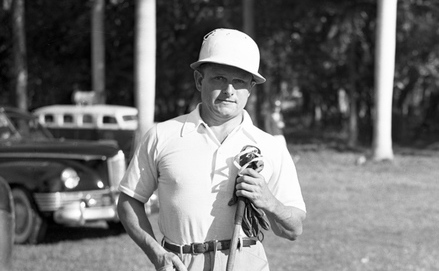
Roy S. Evans in Miami After Leaving American Bantam
The last American Bantam® car rolled out the doors of the Butler, Pennsylvania factory on August 18, 1943. The company manufactured amphibious utility trailers and aerial torpedoes during the war. Roy Evans, Harold Crist and many of the other true “car guys” left American Bantam® in the mid 1940s.
The First Jeep
THE FIRST JEEP 4X4
The FIAT Jeep Wrangler’s story actually begins with the American Bantam® Pilot, the first jeep, designed two months before the Willys Quad. Even today FIAT Jeep continues to mislead customers with half-truths and inaccuracies regarding the invention of the first Jeep.
In June 1940, with World War II on the horizon, as a result of months of lobbying by Charles ‘Harry’ Payne, the American Bantam® salesman who first came up with the idea of a jeep, the U.S. Army Quartermaster (QMC) solicited bids from 135 automakers for a 1/4 ton “light reconnaissance vehicle” tailored to Army QMC specifications.
American Bantam® Car Co. was the only car manufacturer to submit a complete bid. Willys-Overland wasn’t willing to deliver a prototype according to the schedule laid out by the Army QMC and Ford didn’t even bother submitting a bid. Willys and Ford weren’t really interested in the reconnaissance vehicle project until after American Bantam® delivered the first Jeep, the Bantam® Pilot, to Fort Holabird in Maryland.
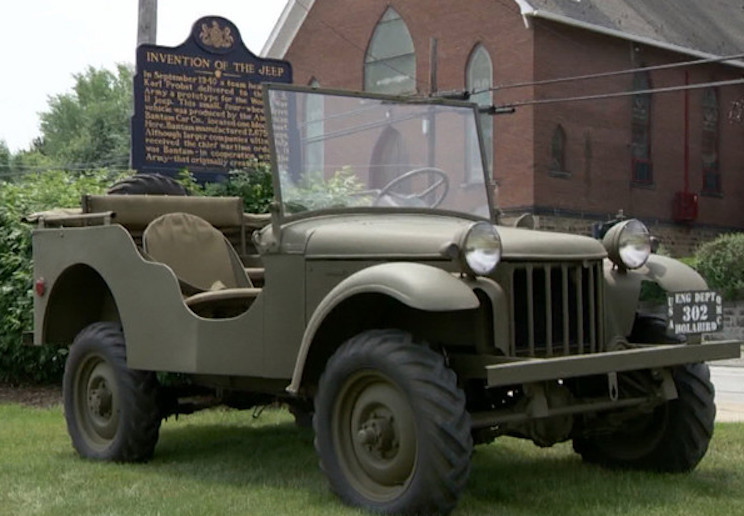
American Bantam® Pilot – The First Jeep
The American Bantam® Pilot was truly a revolutionary vehicle weighing only 1,940 lbs. and built by American Bantam® in only 49 days yet rugged enough to withstand abuse by an Army QMC intent on driving (and flying) the Pilot to it’s breaking point. The Army marveled at the amazing jeep invented by American Bantam® and quickly realized they would need hundreds of thousands of these vehicles. The US Army QMC gave Willys and Ford blueprints of the Bantam® Pilot and gave them access to the vehicle to aid the design their prototype vehicles.
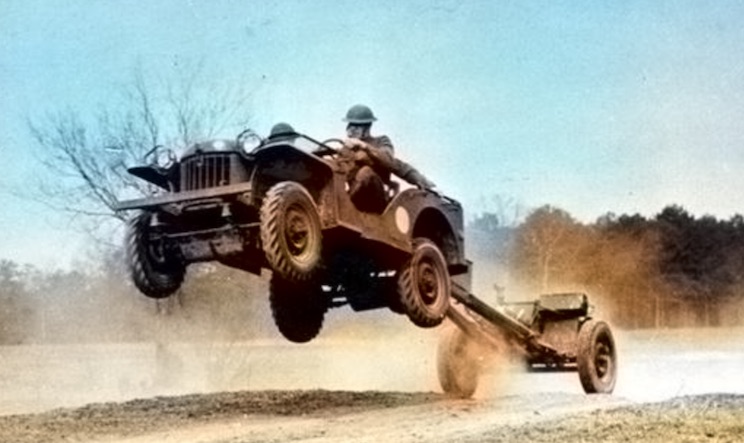
Flying American Bantam® Jeep
In November 1940 American Bantam® kicked off the first volume production run for jeeps with the manufacture of the BRC-60. The same month Willys-Overland finally delivered their prototype “Quad” to the U.S. Army; two months after American Bantam® delivered the first Jeep to the Army QMC. The Willys Quad copied the hood, grille, door shape and drivetrain design directly from American Bantam®, but the Willys Quad weighed 2,520 pounds, nearly 600 pounds (25%) heavier than the American Bantam® Pilot.

American Bantam® BRC-60 – The First Volume Production Jeep
In November 1940 American Bantam® kicked off the first volume production run for jeeps with the manufacture of the BRC-60. The same month Willys-Overland finally delivered their prototype “Quad” to the U.S. Army; two months after American Bantam® delivered the first Jeep to the Army QMC. The Willys Quad copied the hood, grille, door shape and drivetrain design directly from American Bantam®, but the Willys Quad weighed 2,520 pounds, nearly 600 pounds (25%) heavier than the American Bantam® Pilot.
FIAT likes to boast that Willys cobbled together the Quad in a “remarkable 75 days”, especially remarkable because Willys copied the Pilot which American Bantam® invented and built from scratch in less time and without a copying competitor’s designs. The Army QMC rejected the Willys Quad because it was too heavy and sent Willys back to redesign and reduce weight from their American Bantam® Pilot copy. The second time around Willys again borrowed design features from both Ford and American Bantam®, including the flat grille FIAT jeeps are famous for today. Within a year’s time the three companies collectively produced the template for the vehicle known worldwide as the “Jeep” by improving the first vehicle conceived and invented by American Bantam®.
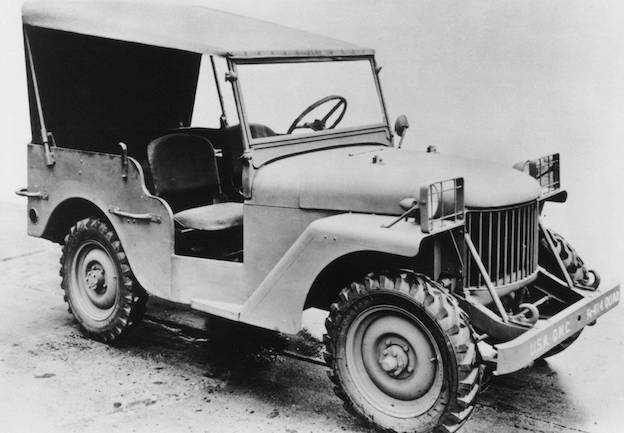
Willys-Overland Quad – American Bantam® Pilot Copy?
Willys-Overland Motors, Inc. Cease and Desist Order, Federal Register, April 28, 1948, Page 2290.
After World War 2 Willys-Overland used to brag that they created the Jeep. On April 27, 1948 the US government Federal Trade Commission issued a Cease and Desist Order against Willys-Overland prohibiting them from “Representing, directly or by implication, that Willys-Overland either acting alone or in cooperation or collaboration with the US Army or with any other agency or party, created or designed the automotive vehicle known as the Jeep.”
The notion that the Willys-Overland Quad was “The First Jeep Brand 4×4” is ludicrous: the first Jeep was invented by American Bantam®. The first vehicle to be called a Jeep was an American Bantam®. The first Jeep to go into battle during World War 2 was an American Bantam®. In 1940 the American Bantam® Jeep was in mass production while Willys would wait until 1941 before finally receiving a volume order to produce Jeeps.
There you go FIAT, we fixed it for you!
World War 2
AMERICAN BANTAM® IN WW2
American Bantam® began delivering the first mass production BRC-60 jeeps to the US Army on November 23, 1940. The American Bantam® BRC-60 was the first jeep to enter military combat, used by the British during a campaign in northern Africa. The British SAS relied on heavily armed jeeps in North Africa missions. While the first batch of BRC-60 jeeps was in production the US Army came back with a purchase order for 1,500 more jeeps.
After successfully delivering the BRC-60 the US Army increased the Jeep minimum weight specification to enable Ford and Willys to compete. American Bantam® strengthened their already rugged chassis design and the new jeep was designated the BRC-40. Production of the BRC-40 began on March 31, 1941 to fulfill the Army’s 1,500 jeep outstanding purchase order.
First US Army Purchase Order for volume production American Bantam jeeps.
By December 6, 1941 American Bantam® had manufactured 2,605 BRC-40 jeeps for the US, China and Russian armies. The BRC-40 was the lightest and most nimble of the three competing models, and the Army lauded its suspension, brakes, and fuel economy. The American Bantam® BRC-40 jeep was preferred over the Willys and Fords by China and Russian militaries because of its light weight and better gas mileage.
During the summer of 1941 the Army QMC made the decision to award the Jeep manufacturing contract to Willys because their bid was $40 cheaper than the American Bantam. The president of American Bantam Francis Fenn went to Washington to testify in the Senate and protest the award of the contract to Willys. Fenn had been told by his contacts in the QMC that they had been ordered to award to contract to Willys-Overland by John D. Biggers, director of production in the Office of Production Management.
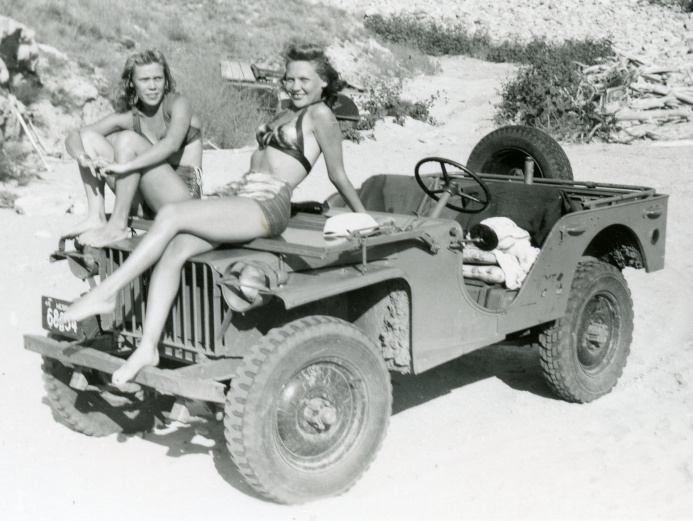
Enzo Ferrari famously called the Jeep “America’s only real sports car.” Pictured: American Bantam BRC-40 Jeep
In the end the Army QMC awarded the contract to produce standardized jeeps to Willys-Overland. Many believe that when Henry Ford heard about this he twisted some arms and half the production was turned over to Ford. American Bantam® was issued a contract to produce amphibious trailers to be towed by Jeeps and other military vehicles. During the war American Bantam® produced 73,689 T3 trailers made its best effort to continue producing civilian trailers after the war.
After it became clear American Bantam® would not manufacture any jeeps for military production American Bantam® resumed their production of civilian vehicles to reduce their parts inventory. On August 18, 1943 the last American Bantam® rolled off the assembly line in Butler, Pennsylvania.

A US Army Jeep towing an American Bantam Trailer
All together American Bantam® delivered 2,676 Bantam® jeeps leading up to the United States entry into WW2 in six different models:
- American Bantam® Pilot (1 units)
- American Bantam® BRC-60 (62 units)
- American Bantam® BRC-60 4-wheel steering (8 units)
- American Bantam® BRC-40 (1,500 units)
- American Bantam® BRC-40 4-wheel steering (62 units)
- American Bantam® BRC-40a (1,043 units)
The invention of the jeep was critical to the allies victory in WW2, both in Europe and in Asia. In the words of the Pulitzer Prize–winning war journalist Ernie Pyle: “It does everything. It goes everywhere. It’s as faithful as a dog, as strong as a mule and as agile as a goat. It constantly carries twice what it was designed for, and still keeps on going.”
After WW2
AFTER THE WORLD WAR 2
After the war when military procurement ended American Bantam® struggled to find a place in the civilian trailer market until it was absorbed by the Monroe Company, a division of Willys-Overland, in July, 1947. Willys’ directors assumed control stripping the Butler, Pennsylvania factory of valuable tooling and equipment and siphoning off profits, forcing the company to seek bankruptcy protection in 1950.
1945 Ad for American Bantam Civilian Trailers
In 1946 James Brannan used his contacts within Ford to purchase the Gwinnett County Ford dealership and within 4 years Brannan Auto had built two dealerships in the Atlanta suburbs. In the early 1960s James Brannan sold the Ford dealerships and together with his son ‘Jimmy’ F. Brannan Jr. incorporated Brannan Auto Parts, Inc. The new company focused on aftermarket auto parts distribution, building up a chain of auto parts stores and under Jimmy Brannan’s leadership becoming a leading auto parts distributor in the southeast USA.
Charlie Paglee first started working for Brannan Auto in 1980 as a young teenager and in 1993 Mr. Paglee moved to China and began visiting factories and purchasing auto parts in China. Brannan Auto established an office in China in 2007 with Charlie Paglee as the China General Manager. Brannan Auto’s chain of auto parts stores in the USA was acquired by CarQuest in 2008 which is now part of the Advanced Auto group.
Brannan Auto expanded its China operations in 2010 opening offices in Shanghai and Beijing and in 2012 Charlie Paglee became the main shareholder of the company. Brannan Auto leveraged automotive engineering, manufacturing experience and knowledge of China’s off-road industry to become a leading supplier of automotive components for smaller OEM automobile manufacturers.
In 2013 Brannan Auto acquired the rights to American Bantam® brand and in 2015 Brannan Auto delivered its first off-road vehicle to a US customer but quickly realized a much more durable design was required. Brannan Auto began designing and engineering a new off-road vehicle in 2015 with an entirely new steel body and rugged chassis design focused on durability and performance. Brannan Auto produced a prototype vehicle in 2018 and after thorough testing determined it still needed a more durable chassis design and a stronger drivetrain.
In 2019 the new American Bantam Car Corporation was incorporated and immediately acquired Brannan Auto Parts, Inc. in the USA and Brannan Auto Engineering Co., Ltd. in China. The combined company has spent the last four years engineering, tooling, testing and validating the new vehicle design for durability and performance. American Bantam® will launch production of the American Bantam® vehicles in 2020.

